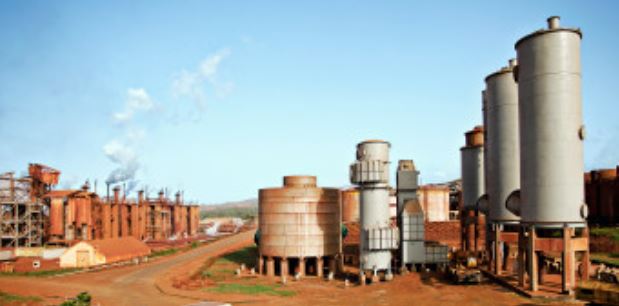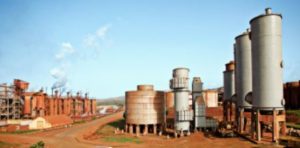Cuba’s Canadian mining partner is bullish on nickel outlook

The Moa nickel-cobalt operation, a 50-50 joint venture with the Cuban government. Source Sherritt International Inc.
By Peter Kennedy

Nickel is back on investor radar screens amid hopes that growing electric vehicle demand will boost consumption of the base metal.
That’s good news for Sherritt International Inc. [S-TSX] a Toronto-based company that is engaged in a nickel mining joint venture with the Cuban government.
The 50/50 partnership, formed in 1994, involves the extraction and processing of nickel and cobalt from an open pit mine at Moa Bay, eastern Cuba.
The laterite nickel ore is processed on site, producing mixed sulphides (containing nickel and cobalt) that are shipped in bags to Halifax, Nova Scotia, and then transported by rail to a refinery in Fort Saskatchewan, Alberta.
Prior to the Cuban revolution in 1959, the operation was owned by a predecessor of U.S. mining giant Freeport McMoran Inc. [FCX-NYSE].
In a telephone interview with Resource World, Sherritt International CEO David Pathe said the company has been through tough times in recent years. But after wiping about $2 billion debt off its balance sheet and restructuring its ownership in the Ambatovy nickel mine in Madagascar, Pathe said he is feeling more optimistic about the company’s future.
“Commodity prices look the most promising [I have] seen since the time I have been in this role,” Pathe said.
“The cobalt price has moved significantly and there has been lots of speculation about how much further it has to run. More important to us, we are finally seeing nickel prices start to respond.”
Sherritt International holds a diverse portfolio of oil and gas, power, fertilizer and mining assets But its flagship asset is its 50% interest in the Moa Bay joint venture. The company also holds a 12% stake in the Ambatovy nickel-cobalt operation, following a restructuring that reduced its interest from 40%.
Pathe estimated that every dollar move in the nickel price is worth about US$40 million to Sherritt in cash flow.
Due to the impact of heavy rainfall in Cuba, and rail transportation delays in Canada, Moa Bay produced 2,854 tonnes of nickel and 336 tonnes of cobalt in the first quarter. Nickel production was 26% below levels seen in the first quarter of 2017. Q1 cobalt was down 23% from the equivalent 2017 quarter.
However, since those issues have been resolved the company now expects to achieve the lower end of its Moa joint venture production forecasts in 2018.
Aside from weather-related issues in Cuba and Madagascar, Sherritt was hit hard by weakness in the price of nickel, which averaged just US$4.72 a pound last year. It’s worth recalling that in 2007, the year before the global financial meltdown, spot nickel averaged US$16.87 a pound.
However, Pathe said his optimism is driven by the recent rally in the nickel price, which averaged US$6.03 a pound in the first quarter of 2018, up 29% from US$4.66 in the equivalent 2017 period.
The average price in the first quarter was the highest since the first quarter of 2015.
In its financial statements, Sherritt said the improvement in the price of nickel was driven by a number of developments, including a growing understanding of the important role that Class 1 nickel will play in the growing electric vehicle market.
“Class 1 nickel, along with cobalt, are key metals needed to manufacture electric vehicle batteries,” the company said.
“Demand for Class 1 nickel and cobalt are expected to grow significantly beginning in 2019 when China expects to begin production quotas requiring that 10% of all vehicles manufactured by electric,” the company added.
It should be noted here that according to the International Nickel Study Group, electric vehicle demand accounted for just 3% of nickel demand in 2017.
By comparison, two-thirds of nickel supply is dedicated to stainless steel production.
However, as adoption rates in the electric vehicle sector continue to grow, EVs are expected to account for a bigger share of overall nickel demand.
“It depends on what rate of adoption you want to assume for electric vehicles,” Pathe said.
In a recent report, Scotiabank said zinc and nickel prices have maintained their upward trek as supply deficits continue to eat away at inventories. However, the report said high inventories have insulated the market from a growing supply deficit that is expected to drive the price higher in the near future. According to Scotiabank forecasts, the price of nickel is expected to average US$6.01 this year and US$6.50 in 1919.
“There are potentially several years ahead of nickel deficits in terms of production, compared to consumption,” Pathe said.
The Sherritt CEO said investors may not be aware that only certain types of nickel are available for battery production. They include the Class 1 nickel that Sherritt and the Cuban government are producing from lateritic ore at Moa Bay.
“Pig iron and ferronickel can’t be used for anything other than stainless steel,” he said.
“What people are coming to realize is that no matter how much ferronickel and pig iron comes out of Indonesia, the Philippines and China, no quantity of that adds to the supply that is available for battery production. For battery production, you need Class 1 nickel and there are only about a dozen facilities around the world that produce Class 1 nickel.”
Analyst Jacques Wortman of Eight Capital has a buy rating on Sherritt International. However, Wortman lowered his target price to $2.10 from $2.20 after the company released its Q1 financial results.
“Sherritt remains one of our top picks based on its nickel/cobalt pure play status, the strengthening nickel market fundamentals, and optionality for medium to long term electric vehicle theme,” he said.
Sherritt was trading Thursday at $1.16 in a 52-week range of $1.87 and 74 cents.
